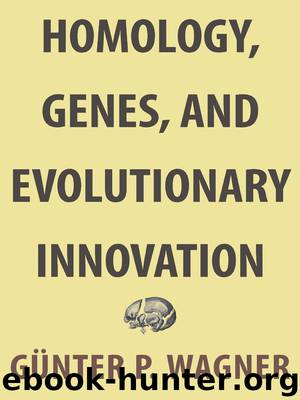Homology, Genes, and Evolutionary Innovation by Wagner Günter P.;

Author:Wagner, Günter P.;
Language: eng
Format: epub
Publisher: Princeton University Press
Published: 2014-12-08T16:00:00+00:00
Definitions and Models
In the sciences and elsewhere, it is usually good advice to define a term when it is first used in a text or in a talk. The purpose, of course, is to give precise meaning to the term in order to facilitate communication. There is, however, a more insidious side to this advice that is usually overlooked and which can be damaging in a field of research that is still in flux and for which precise meanings are hard to come by, as briefly exemplified in the last section with the history of the concept of an acid.
Chemists had to change their definition to come to a deeper understanding of the nature of acids and bases. Rather than being a nuisance, changing definitions can be a good thing if the facts ask for it. But perhaps we can avoid definitions altogether, and yet still gain precision without them. Before we explore this more radical possibility, let us consider first those situations in which definitions work well.
There are two general situations for which definitions, as a precise and terse statement of the meaning of a term, work well. These are in the formal sciences and in mature empirical sciences. By formal sciences I mean mathematics, logic, and computer science for which definitions are used to construct concepts. “A circle is the set of all points in the Euclidean plane that all have the same distance to a given point.” “A semigroup is a set S with an operation *, such that for all a, b, and c in S, we have a * (b * c) = (a * b) * c.” In these examples, the definition, in a way, creates a concept of a “circle” and a “semigroup.” All that can be potentially known about these concepts is implicitly contained in the definition. This is the way to go in the formal sciences and the use of definitions is all but unavoidable.
The other situations for which definitions work well are mature empirical sciences in which the theoretical framework and the empirical practices are well established. “Oxygen is the element with the atomic number 8.” This is all a chemist needs to know to determine what he/she is talking about when the term oxygen is used. To understand why and how this works, one has to realize that, for a layperson, this “definition” is pretty useless. What does it mean to talk about a “chemical element,” or of an “atomic number?” Try to explain this to your grandmother and, unless she already has a PhD in one of the sciences, you will not get very far in your explanation. Even the explanation that the atomic number corresponds to the number of protons in the nucleus will not help much. Besides, how do I know how many protons are in anything so that I find out whether something is an oxygen or not?
The definition of oxygen makes sense only within the broader theoretical context of atomic physics and the experimental practice of chemistry.
Download
This site does not store any files on its server. We only index and link to content provided by other sites. Please contact the content providers to delete copyright contents if any and email us, we'll remove relevant links or contents immediately.
Sapiens: A Brief History of Humankind by Yuval Noah Harari(14216)
Sapiens by Yuval Noah Harari(5281)
Pale Blue Dot by Carl Sagan(4886)
Homo Deus: A Brief History of Tomorrow by Yuval Noah Harari(4801)
Livewired by David Eagleman(3663)
Origin Story: A Big History of Everything by David Christian(3631)
Brief Answers to the Big Questions by Stephen Hawking(3357)
Inferior by Angela Saini(3260)
Origin Story by David Christian(3132)
Signature in the Cell: DNA and the Evidence for Intelligent Design by Stephen C. Meyer(3055)
The Gene: An Intimate History by Siddhartha Mukherjee(3029)
The Evolution of Beauty by Richard O. Prum(2925)
Aliens by Jim Al-Khalili(2776)
How The Mind Works by Steven Pinker(2714)
A Short History of Nearly Everything by Bryson Bill(2616)
Sex at Dawn: The Prehistoric Origins of Modern Sexuality by Ryan Christopher(2472)
From Bacteria to Bach and Back by Daniel C. Dennett(2432)
Endless Forms Most Beautiful by Sean B. Carroll(2414)
Who We Are and How We Got Here by David Reich(2385)
